Social Determinants of Health and Health Inequities: An Overview
VerifiedAdded on 2022/08/11
|5
|1097
|24
Essay
AI Summary
This paper explores the social determinants of health, focusing on the impact of economic conditions on health outcomes, particularly among Native American populations. It introduces social determinants as factors influencing health and the risk of developing diseases, emphasizing the role of socioeconomic status. The discussion highlights health disparities faced by Native Americans, including higher rates of chronic conditions, lower life expectancy, and increased mortality rates, often linked to factors like discrimination, substance abuse, and mental health issues. The paper underscores the importance of addressing these issues through targeted health policies and services to improve access to healthcare, nutrition, and other resources, ultimately aiming to reduce health inequities and enhance the overall quality of life for vulnerable populations. The conclusion reinforces the strong connection between social determinants, such as low socioeconomic status, and health outcomes, advocating for interventions to mitigate these disparities.
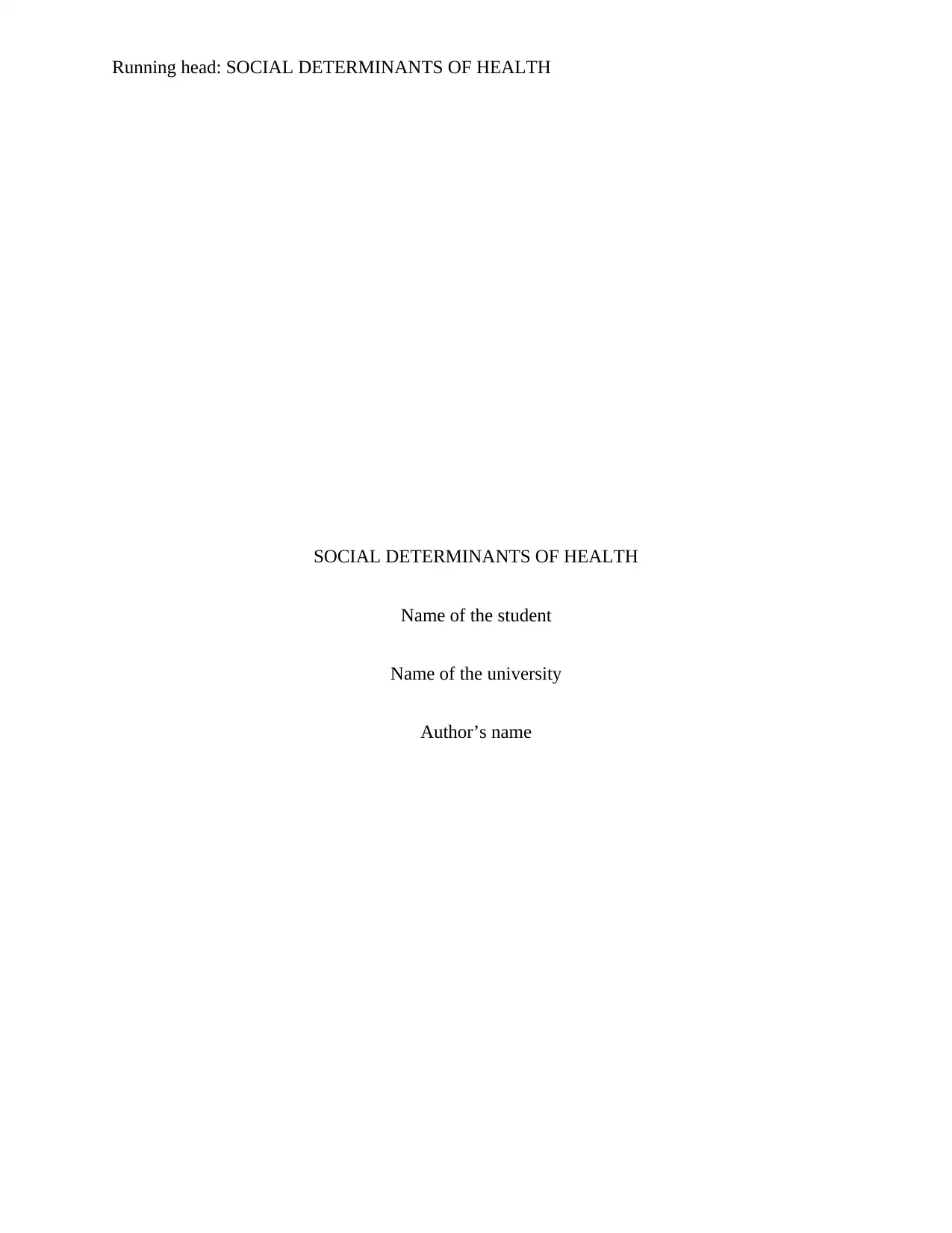
Running head: SOCIAL DETERMINANTS OF HEALTH
SOCIAL DETERMINANTS OF HEALTH
Name of the student
Name of the university
Author’s name
SOCIAL DETERMINANTS OF HEALTH
Name of the student
Name of the university
Author’s name
Paraphrase This Document
Need a fresh take? Get an instant paraphrase of this document with our AI Paraphraser
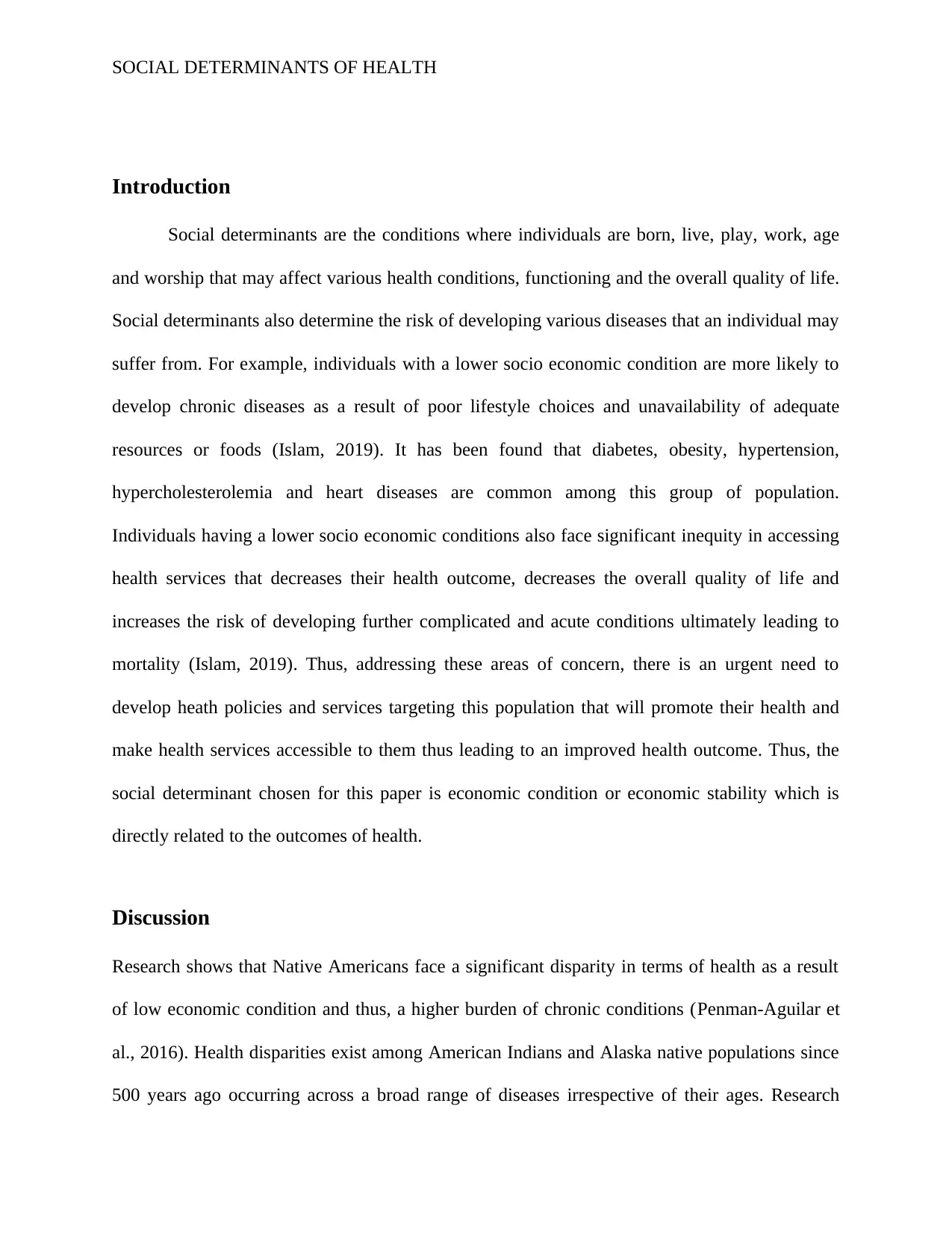
SOCIAL DETERMINANTS OF HEALTH
Introduction
Social determinants are the conditions where individuals are born, live, play, work, age
and worship that may affect various health conditions, functioning and the overall quality of life.
Social determinants also determine the risk of developing various diseases that an individual may
suffer from. For example, individuals with a lower socio economic condition are more likely to
develop chronic diseases as a result of poor lifestyle choices and unavailability of adequate
resources or foods (Islam, 2019). It has been found that diabetes, obesity, hypertension,
hypercholesterolemia and heart diseases are common among this group of population.
Individuals having a lower socio economic conditions also face significant inequity in accessing
health services that decreases their health outcome, decreases the overall quality of life and
increases the risk of developing further complicated and acute conditions ultimately leading to
mortality (Islam, 2019). Thus, addressing these areas of concern, there is an urgent need to
develop heath policies and services targeting this population that will promote their health and
make health services accessible to them thus leading to an improved health outcome. Thus, the
social determinant chosen for this paper is economic condition or economic stability which is
directly related to the outcomes of health.
Discussion
Research shows that Native Americans face a significant disparity in terms of health as a result
of low economic condition and thus, a higher burden of chronic conditions (Penman-Aguilar et
al., 2016). Health disparities exist among American Indians and Alaska native populations since
500 years ago occurring across a broad range of diseases irrespective of their ages. Research
Introduction
Social determinants are the conditions where individuals are born, live, play, work, age
and worship that may affect various health conditions, functioning and the overall quality of life.
Social determinants also determine the risk of developing various diseases that an individual may
suffer from. For example, individuals with a lower socio economic condition are more likely to
develop chronic diseases as a result of poor lifestyle choices and unavailability of adequate
resources or foods (Islam, 2019). It has been found that diabetes, obesity, hypertension,
hypercholesterolemia and heart diseases are common among this group of population.
Individuals having a lower socio economic conditions also face significant inequity in accessing
health services that decreases their health outcome, decreases the overall quality of life and
increases the risk of developing further complicated and acute conditions ultimately leading to
mortality (Islam, 2019). Thus, addressing these areas of concern, there is an urgent need to
develop heath policies and services targeting this population that will promote their health and
make health services accessible to them thus leading to an improved health outcome. Thus, the
social determinant chosen for this paper is economic condition or economic stability which is
directly related to the outcomes of health.
Discussion
Research shows that Native Americans face a significant disparity in terms of health as a result
of low economic condition and thus, a higher burden of chronic conditions (Penman-Aguilar et
al., 2016). Health disparities exist among American Indians and Alaska native populations since
500 years ago occurring across a broad range of diseases irrespective of their ages. Research
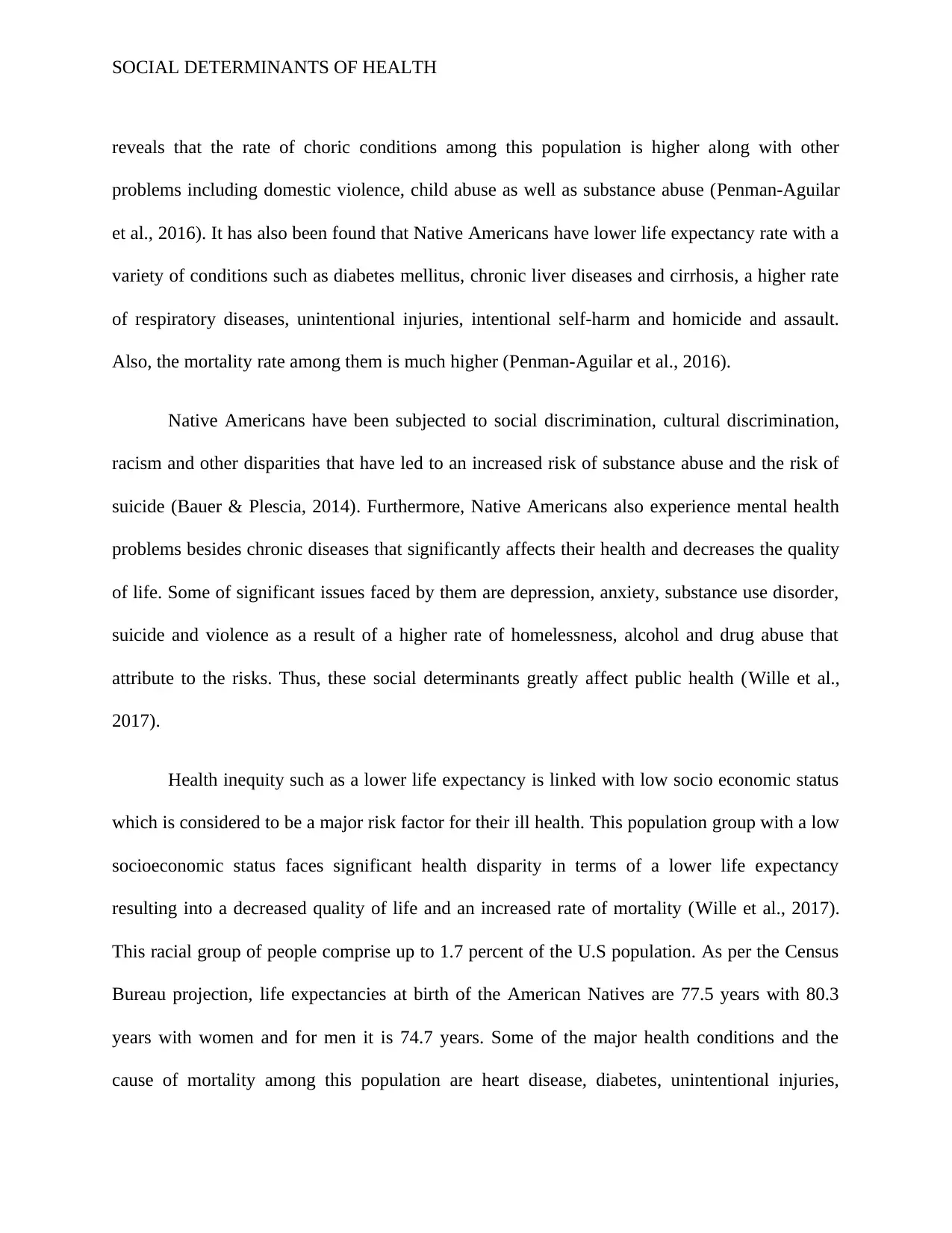
SOCIAL DETERMINANTS OF HEALTH
reveals that the rate of choric conditions among this population is higher along with other
problems including domestic violence, child abuse as well as substance abuse (Penman-Aguilar
et al., 2016). It has also been found that Native Americans have lower life expectancy rate with a
variety of conditions such as diabetes mellitus, chronic liver diseases and cirrhosis, a higher rate
of respiratory diseases, unintentional injuries, intentional self-harm and homicide and assault.
Also, the mortality rate among them is much higher (Penman-Aguilar et al., 2016).
Native Americans have been subjected to social discrimination, cultural discrimination,
racism and other disparities that have led to an increased risk of substance abuse and the risk of
suicide (Bauer & Plescia, 2014). Furthermore, Native Americans also experience mental health
problems besides chronic diseases that significantly affects their health and decreases the quality
of life. Some of significant issues faced by them are depression, anxiety, substance use disorder,
suicide and violence as a result of a higher rate of homelessness, alcohol and drug abuse that
attribute to the risks. Thus, these social determinants greatly affect public health (Wille et al.,
2017).
Health inequity such as a lower life expectancy is linked with low socio economic status
which is considered to be a major risk factor for their ill health. This population group with a low
socioeconomic status faces significant health disparity in terms of a lower life expectancy
resulting into a decreased quality of life and an increased rate of mortality (Wille et al., 2017).
This racial group of people comprise up to 1.7 percent of the U.S population. As per the Census
Bureau projection, life expectancies at birth of the American Natives are 77.5 years with 80.3
years with women and for men it is 74.7 years. Some of the major health conditions and the
cause of mortality among this population are heart disease, diabetes, unintentional injuries,
reveals that the rate of choric conditions among this population is higher along with other
problems including domestic violence, child abuse as well as substance abuse (Penman-Aguilar
et al., 2016). It has also been found that Native Americans have lower life expectancy rate with a
variety of conditions such as diabetes mellitus, chronic liver diseases and cirrhosis, a higher rate
of respiratory diseases, unintentional injuries, intentional self-harm and homicide and assault.
Also, the mortality rate among them is much higher (Penman-Aguilar et al., 2016).
Native Americans have been subjected to social discrimination, cultural discrimination,
racism and other disparities that have led to an increased risk of substance abuse and the risk of
suicide (Bauer & Plescia, 2014). Furthermore, Native Americans also experience mental health
problems besides chronic diseases that significantly affects their health and decreases the quality
of life. Some of significant issues faced by them are depression, anxiety, substance use disorder,
suicide and violence as a result of a higher rate of homelessness, alcohol and drug abuse that
attribute to the risks. Thus, these social determinants greatly affect public health (Wille et al.,
2017).
Health inequity such as a lower life expectancy is linked with low socio economic status
which is considered to be a major risk factor for their ill health. This population group with a low
socioeconomic status faces significant health disparity in terms of a lower life expectancy
resulting into a decreased quality of life and an increased rate of mortality (Wille et al., 2017).
This racial group of people comprise up to 1.7 percent of the U.S population. As per the Census
Bureau projection, life expectancies at birth of the American Natives are 77.5 years with 80.3
years with women and for men it is 74.7 years. Some of the major health conditions and the
cause of mortality among this population are heart disease, diabetes, unintentional injuries,
⊘ This is a preview!⊘
Do you want full access?
Subscribe today to unlock all pages.

Trusted by 1+ million students worldwide
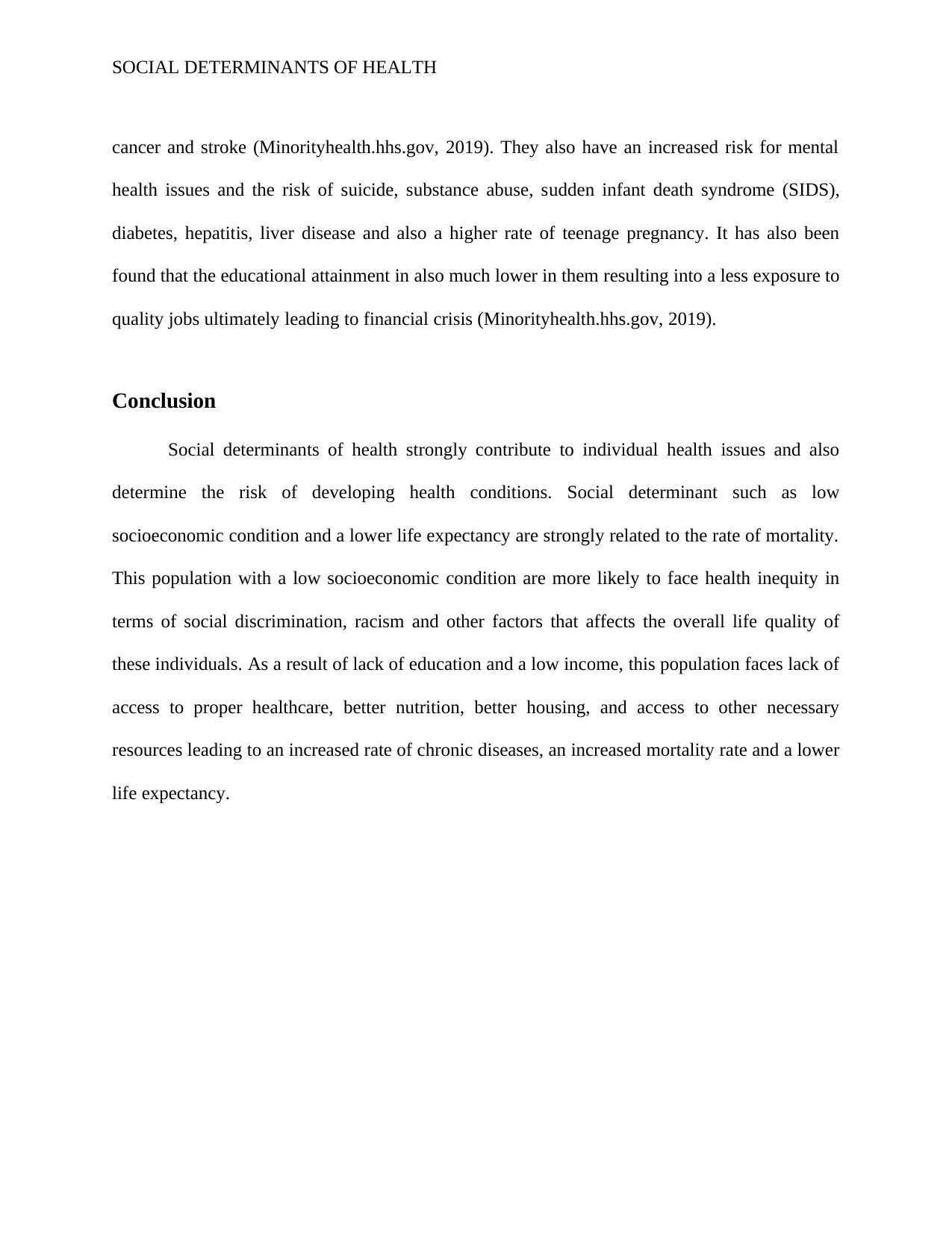
SOCIAL DETERMINANTS OF HEALTH
cancer and stroke (Minorityhealth.hhs.gov, 2019). They also have an increased risk for mental
health issues and the risk of suicide, substance abuse, sudden infant death syndrome (SIDS),
diabetes, hepatitis, liver disease and also a higher rate of teenage pregnancy. It has also been
found that the educational attainment in also much lower in them resulting into a less exposure to
quality jobs ultimately leading to financial crisis (Minorityhealth.hhs.gov, 2019).
Conclusion
Social determinants of health strongly contribute to individual health issues and also
determine the risk of developing health conditions. Social determinant such as low
socioeconomic condition and a lower life expectancy are strongly related to the rate of mortality.
This population with a low socioeconomic condition are more likely to face health inequity in
terms of social discrimination, racism and other factors that affects the overall life quality of
these individuals. As a result of lack of education and a low income, this population faces lack of
access to proper healthcare, better nutrition, better housing, and access to other necessary
resources leading to an increased rate of chronic diseases, an increased mortality rate and a lower
life expectancy.
cancer and stroke (Minorityhealth.hhs.gov, 2019). They also have an increased risk for mental
health issues and the risk of suicide, substance abuse, sudden infant death syndrome (SIDS),
diabetes, hepatitis, liver disease and also a higher rate of teenage pregnancy. It has also been
found that the educational attainment in also much lower in them resulting into a less exposure to
quality jobs ultimately leading to financial crisis (Minorityhealth.hhs.gov, 2019).
Conclusion
Social determinants of health strongly contribute to individual health issues and also
determine the risk of developing health conditions. Social determinant such as low
socioeconomic condition and a lower life expectancy are strongly related to the rate of mortality.
This population with a low socioeconomic condition are more likely to face health inequity in
terms of social discrimination, racism and other factors that affects the overall life quality of
these individuals. As a result of lack of education and a low income, this population faces lack of
access to proper healthcare, better nutrition, better housing, and access to other necessary
resources leading to an increased rate of chronic diseases, an increased mortality rate and a lower
life expectancy.
Paraphrase This Document
Need a fresh take? Get an instant paraphrase of this document with our AI Paraphraser
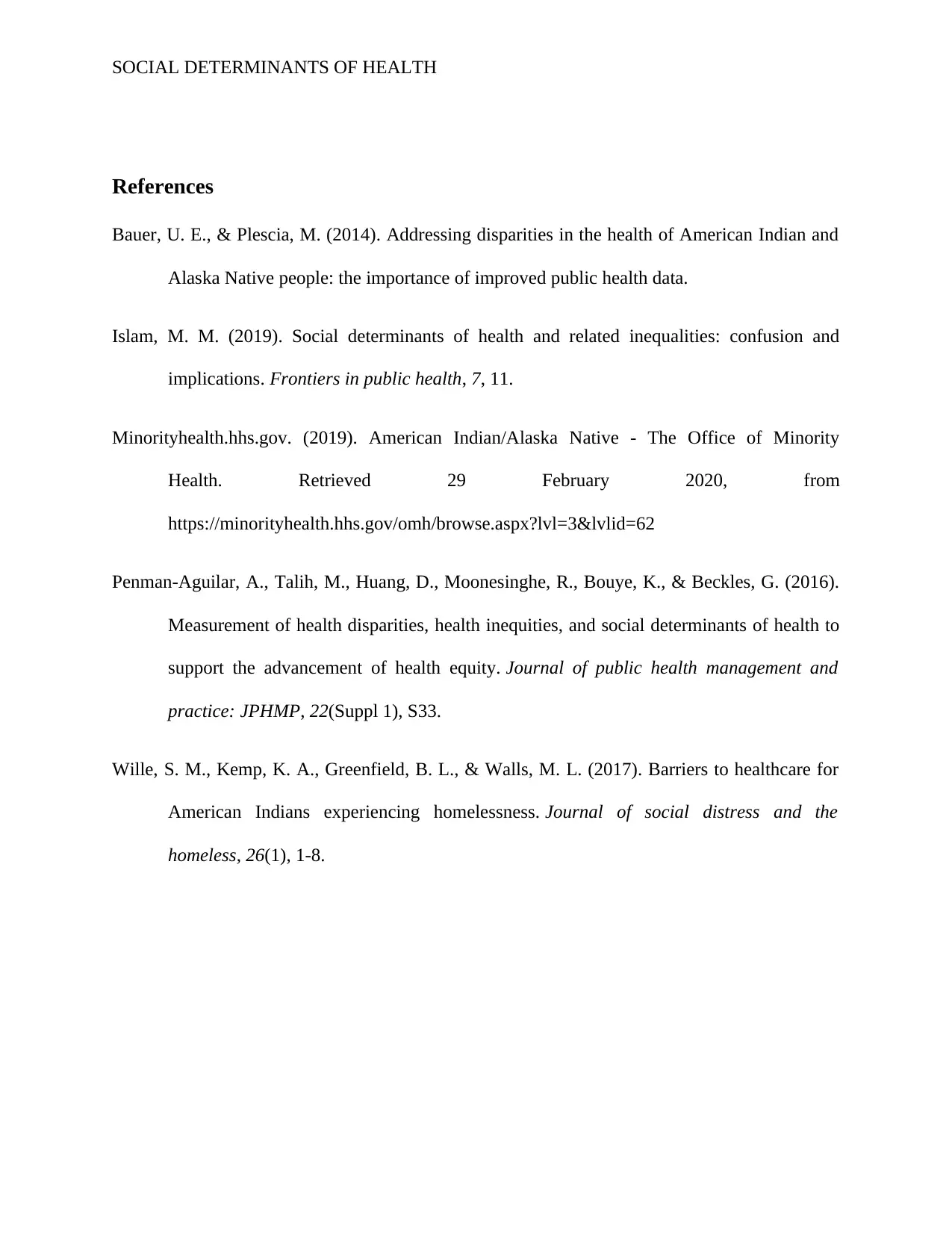
SOCIAL DETERMINANTS OF HEALTH
References
Bauer, U. E., & Plescia, M. (2014). Addressing disparities in the health of American Indian and
Alaska Native people: the importance of improved public health data.
Islam, M. M. (2019). Social determinants of health and related inequalities: confusion and
implications. Frontiers in public health, 7, 11.
Minorityhealth.hhs.gov. (2019). American Indian/Alaska Native - The Office of Minority
Health. Retrieved 29 February 2020, from
https://minorityhealth.hhs.gov/omh/browse.aspx?lvl=3&lvlid=62
Penman-Aguilar, A., Talih, M., Huang, D., Moonesinghe, R., Bouye, K., & Beckles, G. (2016).
Measurement of health disparities, health inequities, and social determinants of health to
support the advancement of health equity. Journal of public health management and
practice: JPHMP, 22(Suppl 1), S33.
Wille, S. M., Kemp, K. A., Greenfield, B. L., & Walls, M. L. (2017). Barriers to healthcare for
American Indians experiencing homelessness. Journal of social distress and the
homeless, 26(1), 1-8.
References
Bauer, U. E., & Plescia, M. (2014). Addressing disparities in the health of American Indian and
Alaska Native people: the importance of improved public health data.
Islam, M. M. (2019). Social determinants of health and related inequalities: confusion and
implications. Frontiers in public health, 7, 11.
Minorityhealth.hhs.gov. (2019). American Indian/Alaska Native - The Office of Minority
Health. Retrieved 29 February 2020, from
https://minorityhealth.hhs.gov/omh/browse.aspx?lvl=3&lvlid=62
Penman-Aguilar, A., Talih, M., Huang, D., Moonesinghe, R., Bouye, K., & Beckles, G. (2016).
Measurement of health disparities, health inequities, and social determinants of health to
support the advancement of health equity. Journal of public health management and
practice: JPHMP, 22(Suppl 1), S33.
Wille, S. M., Kemp, K. A., Greenfield, B. L., & Walls, M. L. (2017). Barriers to healthcare for
American Indians experiencing homelessness. Journal of social distress and the
homeless, 26(1), 1-8.
1 out of 5
Related Documents
Your All-in-One AI-Powered Toolkit for Academic Success.
+13062052269
info@desklib.com
Available 24*7 on WhatsApp / Email
![[object Object]](/_next/static/media/star-bottom.7253800d.svg)
Unlock your academic potential
Copyright © 2020–2025 A2Z Services. All Rights Reserved. Developed and managed by ZUCOL.




